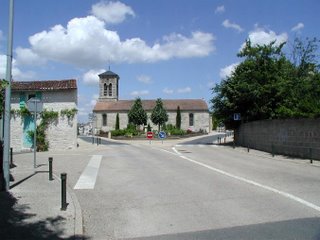Niort to Fontenay
View Niort to Fontenay in a larger map
07:54 start. Tyre sound, or seems so. Air is cool, but sun is hot. Get to Magné in 40 minutes, passing the first Smart I've seen since Paris. In Magné I get distracted by a teen-cat who leaps a wall to avoid having his picture taken, so nearly lose my way.
Coulon after 70 minutes. Tyre OK. Cellette after 2 hours. Tyre still good; but the way the front shocks feel when I get on means that mounting is much squishier than I am used to, which adds to the paranoia. The countryside is flat, with crops of maize or sunflowers, and some wheat, all just knee-high.
I pass half-remembered places that look so different in the full sun. The only clouds are weather passing north, and contrails.
Plenty of frogs croaking in the canals and ditches, with plenty of splashing as I approach. I stop at 10:15 just past Ste. Christine for the traditional marais cattle shot near where I did last year; and soon after I come to where I saw the young cats too; there is a flurry of kittens (10-12 weeks), but mum just stays in the shade.
At Courdault, all is going well, so I take the aside to the port, but it's being worked on and is just a massive excavation, and the road was simply atrocious, pot-holes and grit. Soon after I pass the picnic site I paused to pre-blog at last year. By just after 11:00 I'm past Bouillé on the way to Maillezais, which I think puts me ahead of last years rate. Maybe I ran too fast at the start, or there was too much headwind then; today there's just a refreshing breeze.
4 hours in, and I'm stopped at the picnic place past St. Pierre le Vieux on the way to Souil. I needed to navigate a bit in Maillezais. The roadworks there last year are gone, but the diversion of the road is now a fixture (what was the St Pierre road is a no-entry, and the only decent bit of surface in town). For the first time today I got off and pushed up the hill, having lost momentum while casting around.
On this stretch, I remember places where I got off and pushed, so weary, last year, and now I don't even feel the need to change gears. Even on the way past the walls of the churchyard at St Pierre, which I remember passing with hazy loathing. Then, all of a sudden, when I thought I must have passed it unawares, the leaping stag sign and another remembered picnic place by the bridge.
It's now definitely time for lunch, to finish the bread pud I'd packed, and some local jaffa-cake equivalents. Thoughts of making a long stay in the shade dashed when a whole bunch of other folk turn up, and look rather squeezed around the second, and non-shaded, table, so finish the pud and set off.
The open plain between here and Fontenay that I pushed most of the way through last time is an easy stroll and I can't remember why I worried about the bridge over the main road.
The Rue de Jericho is closed, so thank goodness for previous recon — I just follow the road I'm on to the Avenue Hoche, turn right and follow the signs. It's a little hairy at one of the junctions, but in five hours, and thirty minutes later I'm there on the verandah of the same room as before, drinking a long drink of blood-orange.
After a couple of hours, and a shower, I wander into town for more supplies; drink mainly, and some strawberries for tea. It's too hot to do anything more than flop in the shade; but a bonus is that out on the terrace will be good for dinner.
Millefuile of tomato,aubergine and feta; leg of duck, and a 1/2 bottle of a local rosé (and today that seems to be the tipple of choice, not just my own eccentricity), soft cheeses, then pan-fried pineapple with pepper and rosemary.
While I eat, I see someone hang-gliding in the distance.
By 21:30, the last of the sun is slanting through my room, but it is cool enough that I want my denim shirt over the short-sleeved silk to be comfortable sitting on the verandah and enjoying the last light.






